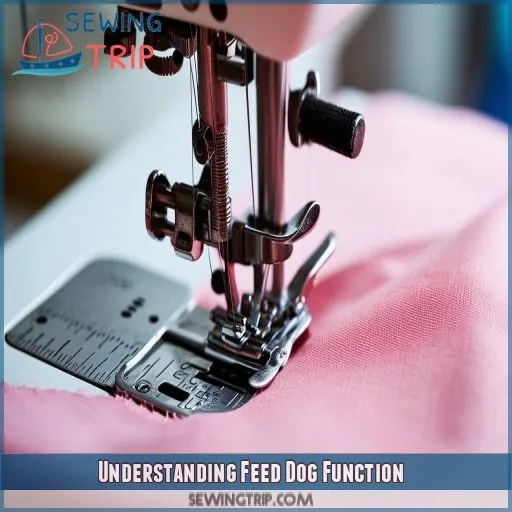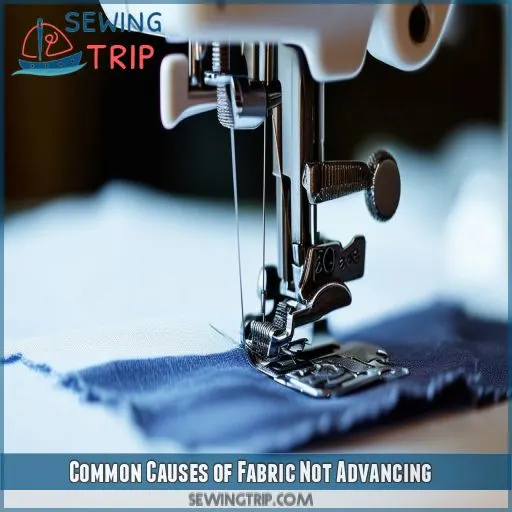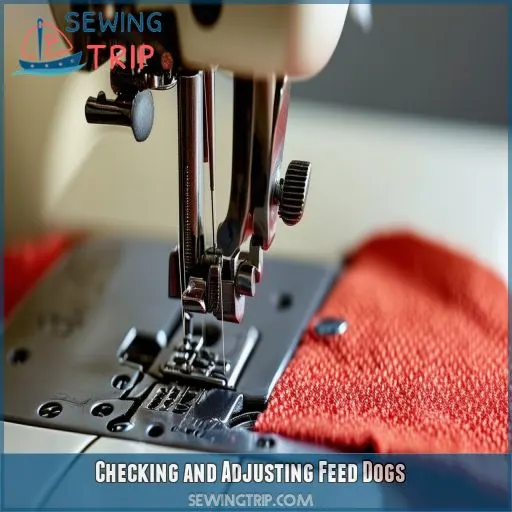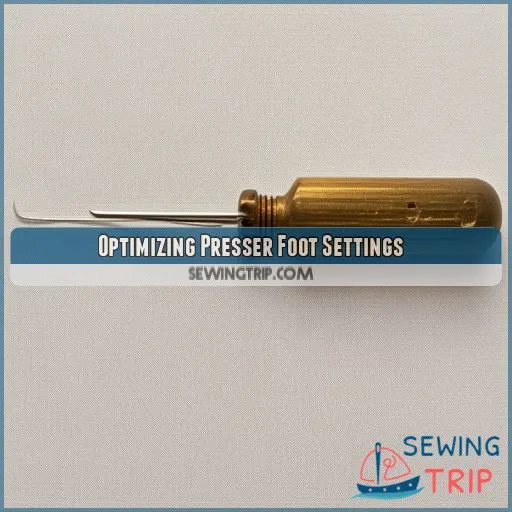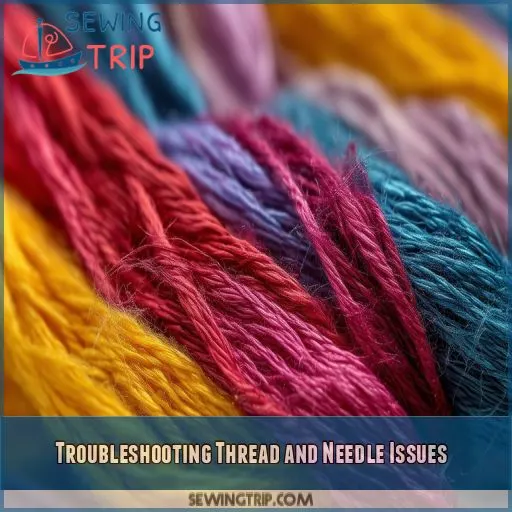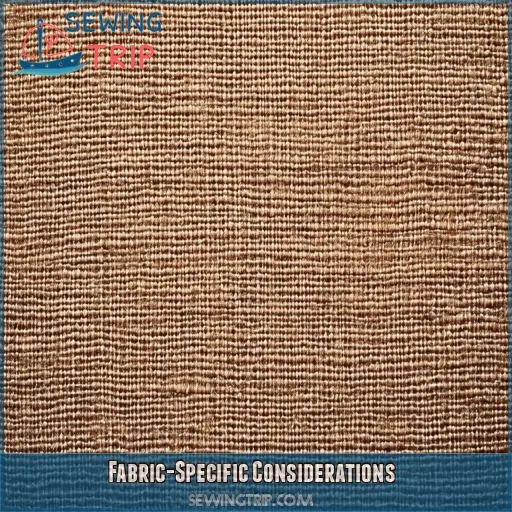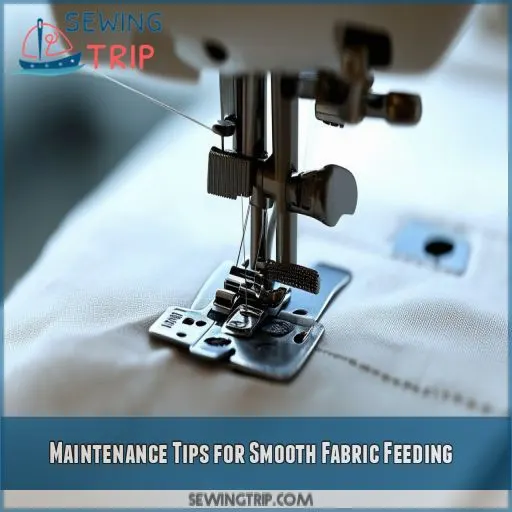This site is supported by our readers. We may earn a commission, at no cost to you, if you purchase through links.

First, understanding what feed dogs do and reasons like height issues with feed dogs, presser foot pressure problems, or even thread tension imbalance help you troubleshoot better.
Our guide includes seven expert solutions for the diagnosis and rectification of issues that cause smooth flow of the fabric.
Get a grip on your sewing machine and learn uninterrupted stitching with the help of professional tips.
Table Of Contents
- Key Takeaways
- Understanding Feed Dog Function
- Common Causes of Fabric Not Advancing
- Checking and Adjusting Feed Dogs
- Optimizing Presser Foot Settings
- Troubleshooting Thread and Needle Issues
- Fabric-Specific Considerations
- Maintenance Tips for Smooth Fabric Feeding
- Frequently Asked Questions (FAQs)
- Conclusion
Key Takeaways
- Feed dogs are the unsung heroes of your sewing machine, gripping and moving fabric through the machine for smooth stitching.
- Common culprits for fabric not advancing include incorrect feed dog height, presser foot pressure, or thread tension imbalances.
- To troubleshoot, check feed dog height, clean feed dogs, adjust presser foot pressure, and ensure balanced thread tension.
- Always use the correct needle size and type, and consider specialty presser feet like a walking foot for tricky fabrics or thick materials.
Understanding Feed Dog Function
Feed dogs are small, toothed metal plates beneath your sewing machine’s needle plate that move fabric through the machine as you sew. They work by rising above the needle plate on each forward stroke, gripping the fabric and pulling it backward in coordination with the needle’s up-and-down motion to create evenly spaced stitches.
What Are Feed Dogs?
These feed dogs very literally are the unsung heroes of the sewing machine. In a nutshell, little metal teeth-like parts under the needle plate hold your fabric and move it. They’re hardened steel, proving that these small workhorses will advance your fabric smoothly.
Proper feed dog pressure, regular cleaning, and lubrication are essential for them to work well.
Whenever your fabric isn’t moving, many times, these tiny guys are on your list of primary suspects to look at during your sewing machine troubleshooting mission.
How Feed Dogs Work
Now that you know what feed dogs are, let’s see how they work. These metal teeth, usually of rugged materials such as steel, move up and down in an elliptical manner.
They rise above the plate over which your needle is running and clasp your fabric, pulling it backward as they go up. This action—coordinated with the up-and-down motion of the needle—ensures smooth advancement or feeding of fabric.
Different feed dog designs and their various settings are essential to know in troubleshooting problems that may develop with fabric feed on a sewing machine.
Common Causes of Fabric Not Advancing
The common issues when this happens, though, will most likely be feed dog height, presser foot pressure, or an imbalance in thread tension.
You’ll need to verify that your feed dogs are at the correct height and adjust the pressure of the presser foot for your particular fabric, as well as ensure that your thread tensions are properly balanced for optimal feeding of the fabric.
Feed Dog Height Issues
Now that you know about feeding dogs, let’s talk about height. When they’re too low or high, your fabric won’t advance.
Check now whether they’re showing above the needle plate as it raises; if they don’t show up, adjustment or even replacement may be necessary.
Proper lubrication and alignment are also essential.
Feed dog maintenance is crucial to avoid any problems with feeding the fabric and to ensure smooth operation of the sewing machine.
Presser Foot Pressure Problems
Presser foot pressure problems can cause misfeeding of fabric. Check on the correctness of your presser foot type and whether it goes well with your material. Make sure the accuracy of the pressure gauge, and where necessary, set it right. Replace presser feet that are worn out.
Response from your foot pedal: Always on the watch for consistency.
Resolve the existence of skipped stitches, puckered seams, or malfunctioning bobbin of your sewing machine to ensure smooth and constant feeding of the fabric.
Thread Tension Imbalances
Tension imbalances will ruin your sewing. Ensure that all settings are suitable for the bobbin tension, upper tension, and spring tension.
Balanced tensions are essential because, if there’s an imbalance, you’ll find that threads break, stitches skip, or the sewing machine stops sewing.
Adjust tension settings based on fabric type for ideal tension to avoid those pesky tension problems during your projects.
Checking and Adjusting Feed Dogs
First, verify the height of your feed dogs and clean them from lint and other debris. If some feed dogs are worn out, replace them. This step is essential to ensure that your fabric advances properly and avoids hitches in your sewing project.
Proper Feed Dog Height
Ensure that the proper feed dog height is in order. If the feed dogs are too low, it will result in skipped stitches, unintended tucks, and accumulation of the fabric.
The wrong height may cause too much friction, resulting in inconsistent sewing. The feeds should be adjusted such that when engaged, they raise slightly above the plate of the needle to avoid problems with light or wrong thickness and make it less likely to break a needle.
Cleaning Feed Dogs
Begin by ensuring your sewing machine is off, then remove the needle plate. Use a small brush or vacuum attachment to clean the feed dog teeth thoroughly. Lint and fabric debris can hinder their function. Don’t forget to check the feed dog height and alignment, as improper settings can cause sewing machine issues like thread breaking or skipped stitches.
Replacing Worn Feed Dogs
If it isn’t cleaned, your feed dogs would be worn out.
Check the compatibility with the model of your machine. Note that sometimes replacing the feed dog reels could make a difference, but their prices vary.
Generally, feed dogs enjoy a good life, but with proper care, you must inspect it periodically.
Always use quality materials and lubricate to avoid many problems, such as bird’s nests.
Optimizing Presser Foot Settings
This will allow the pressure of these feet against the fabric to move along most effectively. That means it’s going to be different for all thicknesses of fabric. Specialty presser feet, like a walking foot for tricky fabrics, can make all the difference in your sewing machine’s performance.
Adjusting Presser Foot Pressure
Now, let’s adjust the presser foot pressure. Correct pressure allows the easy glide of the fabric under the presser foot. Here’s how to do it:
- Adjust Pressure: Turn the adjustment dial based on the thickness of the fabric.
- Match Foot to Fabric: Use the appropriate style of presser foot.
- Sample Settings: Always test on a scrap of fabric.
- Check the Results: Check for even stitching without puckering.
Using Specialty Presser Feet
Specialty presser feet can make all the difference in your sewing. Use these:
| Specialty Presser Foot Types | Usage | |
|---|---|---|
| Edge Joining Presser Foot | Works Wonderfully for Thin Seams | |
| Walking Foot | Ideal for Layered Fabrics | |
| Zipper Foot | Ingredient | Essential for installing any zipper |
| Even Feed Foot | Troubleshoots Uneven Feeding |
Install these feet to increase precision and ensure smooth advancement of fabric.
Troubleshooting Thread and Needle Issues
First, ensure you’re using the correct size and type of needle for your material to smooth fabric advancement. Check the thread path and tension to be precisely set to prevent all kinds of disruptions in fabric feeding.
Correct Needle Size and Type
The proper choice of needle size and type is critical. Needles that are too small or too large in diameter can cause broken needles and skipped stitches.
The point of your needle and its surface should be appropriate for your fabric. If a needle becomes blunt or worn out, it won’t go through quickly.
Check your needle periodically for wear and replace if necessary. It keeps your sewing smooth and continuous.
Thread Path and Tension
Be sure your thread follows the correct path through the tension discs and spring. If your machine isn’t threaded correctly, it will stall your fabric.
Check the tension of the bobbin—smooth flow. Misaligned threading may result in disrupted tension that creates a problem.
Adjust the top and bobbin tension to an even feed where it flows without a hitch in your machine.
Fabric-Specific Considerations
When working with slippery fabrics, use a walking foot and pin sections together to prevent shifting. For thick or layered materials, adjust the presser foot pressure and utilize a height compensation tool to maintain even feeding.
Working With Slippery Fabrics
Working with slippery fabrics can be tricky. Apply slippery fabric adhesives or use fusible interfacing to stabilize the material. A needlepoint presser foot or a walking foot helps maintain grip. Additionally, fabric spray can temporarily stiffen the fabric, making it easier to handle. Don’t pull; let the machine’s feed dogs do the work.
Handling Thick or Layered Materials
Use a walking foot to ensure even feeding while sewing thick or layered materials.
Compensate for height with a fabric stabilization tool or folded fabric under the presser foot.
Presser foot pressure should be adjusted to avoid puckering.
Other thick fabric tricks include slow stitching with a larger needle.
Multilayer sewing techniques will prevent the bunching of your fabric, giving you even seams.
Maintenance Tips for Smooth Fabric Feeding
Clean and oil your sewing machine regularly to ensure smooth feeding and prevent the accumulation of unwanted deposits associated with feed dogs. Adhere to a professional servicing schedule to detect and rectify minor defects, keeping your machine in top shape.
Regular Cleaning and Oiling
Keep your sewing machine running smoothly: clean it regularly and oil at times. Here is how to keep it maintained:
- Daily: After every use, clean off lint from the feed dog area.
- Weekly: Check for fabric or thread snags and remove them.
- Monthly: Lubricate according to the manual’s oiling frequency.
- Annual: Extensive cleaning and lubrication of the feed dog.
Consistent care ensures optimal performance.
Professional Servicing Schedule
Annual professional servicing will help extend the life of your sewing machine. This will likewise include scheduled professional checkups for your sewing machine, along with extended warranties that help in revealing those otherwise hidden problems before they become serious ones. Adhere to a frequency of servicing compatible with its usage intensity. Here’s a quick table for your guidance:
| Usage Frequency | Servicing Frequency | Professional Maintenance | Extended Warranties |
|---|---|---|---|
| Casual (Monthly) | Yearly | Essential | Optional |
| Regular (Weekly) | Bi-Annually | Recommended | Beneficial |
| Heavy (Daily) | Quarterly | Crucial | Highly Recommended |
Keep your machine in top shape!
Frequently Asked Questions (FAQs)
Why are my feed dogs not moving fabric?
Imagine the cloth is slipping instead of stitching. Probably, your feed dogs are disengaged. Raise them. Check your stitch length setting, and clean any lint or other debris from underneath. Adjust presser foot pressure for smooth fabric flow.
How to fix fabric bunching?
Reduce presser foot pressure to prevent the formation of distortion in the fabric. Use a walking foot for even feeding; otherwise, section and pin together. Keep the sewing machine running smoothly by using an appropriate stitch length, maintaining correct thread tension, and cleaning it regularly.
What helps move the fabric forward while sewing?
You know, 49% of fabric doesn’t move ahead because of malfunctioning or improper functioning feed dogs. Keep your feed dogs clean and in the proper position. The correct presser foot pressure and maintaining it at the proper time keep the fabrics moving during sewing.
Why does my fabric keep bunching up?
It bunches up because of incorrect tension or a dull needle or because you threaded it wrong. Be sure to engage your presser foot; now adjust the tension and use the right needle and thread for your fabric.
How does fabric thickness affect stitch length What are signs of a worn feed dog?
Shockingly, fabric thickness can change stitch length by up to 40%. Thick fabrics require longer stitches for balance. Worn feed dogs show uneven teeth, decreased grip, or make your fabric slip instead of feeding smoothly.
Can incorrect needle type affect feed dogs?
Yes, using the incorrect needle type can affect feed dogs. An unsuitable needle can cause uneven fabric feeding, leading to skipped stitches, fabric shifting, or jamming, which ultimately impacts the feed dogs’ performance.
How to manage sewing thicker fabric layers?
Handling thicker fabric layers requires mastery and finesse. Use a height compensation tool, adjust your presser foot pressure, and don’t forget to switch to a larger needle to avoid stitch issues and bird’s nests.
What tools assist with varying fabric heights?
Level sewing foot over thicker sections using a height compensation tool or even a folded piece of fabric. Consider a walking foot to ensure even the movement of the fabric for varying fabric heights.
Conclusion
A stitch in time saves nine."
But knowing what feed dogs do and how to diagnose common issues, such as improper height or pressure of the presser foot to feed dogs, along with thread tension imbalances, will help fix the reason for your sewing machine not moving forward.
Proper maintenance, setting adjustments related to the appropriate feeding of fabric, and considerations regarding type are all in a day’s work.
These seven expert solutions show you how to achieve a smoother, less-interrupted process for stitching with precision every single time.

